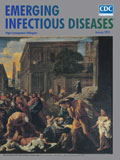
Volume 24, Number 1—January 2018
Letter
Increasing Virulence in Leprosy Indicated by Global Mycobacterium spp.
On This Page
To the Editor: The November 2017 issue of Emerging Infectious Diseases had 3 articles about leprosy, including these topics: a United States–born patient who tested positive for Mycobacterium lepromatosis (1); a lethal case of Mycobacterium leprae manifested as Lucio’s phenomenon in Peru (2); and pointing out that leprosy is an emerging disease in the eastern United States, including autochthonous cases without exposure to armadillos (3), which were previously shown to be a zoonotic source of transmission in the United States (4). Not only is leprosy not disappearing in the United States and globally, but the signs are pointing to a more virulent mycobacterial infection that is likely to be a microbial adaptation to the global use of multidrug therapy, as previously reported (5).
Lucio’s phenomenon is fortunately rare; there is no proven effective therapy for this type 3 reaction in leprosy patients. Historically, Lucio’s phenomenon was confined to Mexico, mostly in cases of diffuse lepromatous leprosy, also referred to as “Leprosy bonita.” In recent years, it has been discovered elsewhere, including the first known case in India in 2001 (6). Two additional cases of lethal Lucio’s leprosy were reported in 2 immigrants from Singapore to the United States, who were shown to have M. lepromatosis and M. leprae (7). The report of Levis et al. is likely confirmed by the recent discovery of M. lepromatosis and Lucio’s outside of Mexico (5).
In summary, leprosy is an emerging infection in the United States, including autochthonous cases in the eastern United States. The reports in the November issue of Emerging Infectious Diseases of autochthonous M. lepromatosis and a lethal case of Lucio’s phenomenon outside Mexico are ominous signs of a more virulent form of emerging leprosy.
References
- Virk A, Pritt B, Patel R, Uhl JR, Bezalel SA, Gibson LE, et al. Mycobacterium lepromatosis lepromatous leprosy in US citizen who traveled to disease-endemic areas. Emerg Infect Dis. 2017;23:1864–6. DOIPubMed
- Ramal C, Casapia M, Marin J, Celis JC, Baldeon J, Vilcarromero S, et al. Diffuse multibacillary leprosy of Lucio and Latapí with Lucio’s phenomenon, Peru. Emerg Infect Dis. 2017;23:1929–30. DOIPubMed
- Rendini T, Levis W. <jrn>3. Rendini T, Levis W. Autochthonous leprosy without armadillo exposure, eastern United States. Emerg Infect Dis. 2017;23:1928. DOIPubMed
- Sharma R, Singh P, Loughry WJ, Lockhart JM, Inman WB, Duthie MS, et al. Zoonotic leprosy in the southeastern United States. Emerg Infect Dis. 2015;21:2127–34. DOIPubMed
- Levis WR, Zhang S, Martiniuk F. Mycobacterium lepromatosis: emerging strain or species? J Drugs Dermatol. 2012;11:158.PubMed
- Saoji V, Salodkar A. Lucio leprosy with lucio phenomenon. Indian J Lepr. 2001;73:267–72.PubMed
- Han XY, Sizer KC, Tan HH. Identification of the leprosy agent Mycobacterium lepromatosis in Singapore. J Drugs Dermatol. 2012;11:168–72.PubMed


































No hay comentarios:
Publicar un comentario